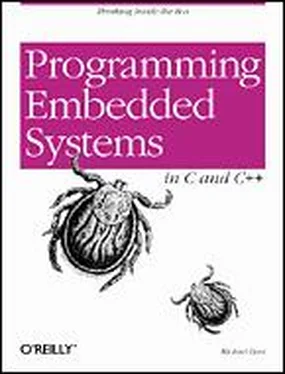#define TIMER1_INT 18
#define TIMER2_INT 19
/*
* On-Chip Serial Ports
*/
#define RX_INT 20
#define TX_INT 21
5.4 Get to Know the Processor
If you haven't worked with the processor on your board before, you should take some time to get familiar with it now. This shouldn't take very long if you do all of your programming in C or C++. To the user of a high-level language, most processors look and act pretty much the same. However, if you'll be doing any assembly language programming, you will need to familiarize yourself with the processor's architecture and basic instruction set.
Everything you need to know about the processor can be found in the databooks provided by the manufacturer. If you don't have a databook or programmer's guide for your processor already, you should obtain one immediately. If you are going to be a successful embedded systems programmer, you must be able to read databooks and get something out of them. Processor databooks are usually well written — as databooks go — so they are an ideal place to start. Begin by flipping through the databook and noting the sections that are most relevant to the tasks at hand. Then go back and begin reading the processor overview section.
5.4.1 Processors in General
Many of the most common processors are members of families of related devices. In some cases, the members of such a processor family represent points along an evolutionary path. The most obvious example is intel's 80x86 family, which spans from the original 8086 to the Pentium II — and beyond. In fact, the 80x86 family has been so successful that it has spawned an entire industry of imitators.
As it is used in this book, the term processor refers to any of three types of devices known as microprocessors, microcontrollers, and digital signal processors. The name microprocessor is usually reserved for a chip that contains a powerful CPU that has not been designed with any particular computation in mind. These chips are usually the foundation of personal computers and high-end workstations. The most common microprocessors are members of Motorola's 68k — found in older Macintosh computers — and the ubiquitous 80x86 families.
A microcontroller is very much like a microprocessor, except that it has been designed specifically for use in embedded systems. Microcontrollers typically include a CPU, memory (a small amount of RAM, ROM, or both), and other peripherals in the same integrated circuit. If you purchase all of these items on a single chip, it is possible to reduce the cost of an embedded system substantially. Among the most popular microcontrollers are the 8051 and its many imitators and Motorola's 68HCxx series. It is also common to find microcontroller versions of popular microprocessors. For example, Intel's 386EX is a microcontroller version of the very successful 80386 microprocessor.
The final type of processor is a digital signal processor, or DSP. The CPU within a DSP is specially designed to perform discrete-time signal processing calculations — like those required for audio and video communications — extremely fast. Because DSPs can perform these types of calculations much faster than other processors, they offer a powerful, low-cost microprocessor alternative for designers of modems and other telecommunications and multimedia equipment. Two of the most common DSP families are the TMS320Cxx and 5600x series from TI and Motorola, respectively.
5.4.2 Intel's 80188EB Processor
The processor on the arcom board is an intel 80188eb-a microcontroller version of the 80186. In addition to the CPU, the 80188EB contains an interrupt control unit, two programmable I/O ports, three timer/counters, two serial ports, a DRAM controller, and a chip-select unit. These extra hardware devices are located within the same chip and are referred to as on-chip peripherals. The CPU is able to communicate with and control the on-chip peripherals directly, via internal buses.
Although the on-chip peripherals are distinct hardware devices, they act like little extensions of the 80186 CPU. The software can control them by reading and writing a 256-byte block of registers known as the peripheral control block (PCB). you may recall that we encountered this block when we first discussed the memory and I/O maps for the board. By default the PCB is located in the I/O space, beginning at address FF00h. However, if so desired, the PCB can be relocated to any convenient address in either the I/O or memory space.
The control and status registers for each of the on-chip peripherals are located at fixed offsets from the PCB base address. The exact offset of each register can be found in a table in the 80188EB Microprocessor User's Manual. To isolate these details from your application software, it is good practice to include the offsets of any registers you will be using in the header file for your board. I have done this for the Arcom board, but only those registers that will be discussed in later chapters of the book are shown here:
/**********************************************************************
*
* On-Chip Peripherals
*
**********************************************************************/
/*
* Interrupt Control Unit
*/
#define EOI (PCB_BASE + 0x02)
#define POLL (PCB_BASE + 0x04)
#define POLLSTS (PCB_BASE + 0x06)
#define IMASK (PCB_BASE + 0x08)
#define PRIMSK (PCB_BASE + 0x0A)
#define INSERV (PCB_BASE + 0x0C)
#define REQST (PCB_BASE + 0x0E)
#define INSTS (PCB_BASE + 0x10)
/*
* Timer/Counters
*/
#define TCUCON (PCB_BASE + 0x12)
#define T0CNT (PCB_BASE + 0x30)
#define T0CMPA (PCB_BASE + 0x32)
#define T0CMPB (PCB_BASE + 0x34)
#define T0CON (PCB_BASE + 0x36)
#define T1CNT (PCB_BASE + 0x38)
#define T1CMPA (PCB_BASE + 0x3A)
#define T1CMPB (PCB_BASE + 0x3C)
#define T1CON (PCB_BASE + 0x3E)
#define T2CNT (PCB_BASE + 0x40)
#define T2CMPA (PCB_BASE + 0x42)
#define T2CON (PCB_BASE + 0x46)
/*
* Programmable I/O Ports
*/
#define P1DIR (PCB_BASE + 0x50)
#define P1PIN (PCB_BASE + 0x52)
#define P1CON (PCB_BASE + 0x54)
#define P1LTCH (PCB_BASE + 0x56)
#define P2DIR (PCB_BASE + 0x58)
#define P2PIN (PCB_BASE + 0x5A)
#define P2CON (PCB_BASE + 0x5C)
#define P2LTCH (PCB_BASE + 0x5E)
Other things you'll want to learn about the processor from its databook are:
• Where should the interrupt vector table be located? Does it have to be located at a specific address in memory? If not, how does the processor know where to find it?
• What is the format of the interrupt vector table? Is it just a table of pointers to ISR functions?
• Are there any special interrupts, sometimes called traps, that are generated within the processor itself? Must an ISR be written to handle each of these?
• How are interrupts enabled and disabled (globally and individually)?
• How are interrupts acknowledged or cleared?
5.5 Study the External Peripherals
At this point, you've studied every aspect of the new hardware except the external peripherals. These are the hardware devices that reside outside the processor chip and communicate with it by way of interrupts and I/O or memory-mapped registers.
Читать дальше












